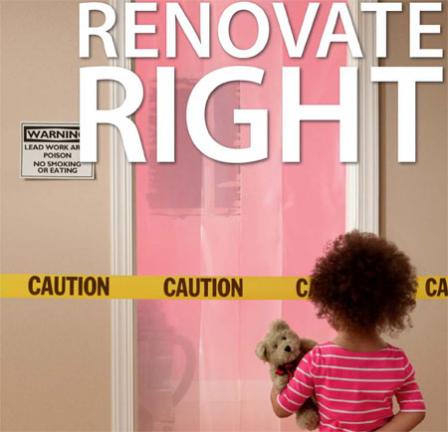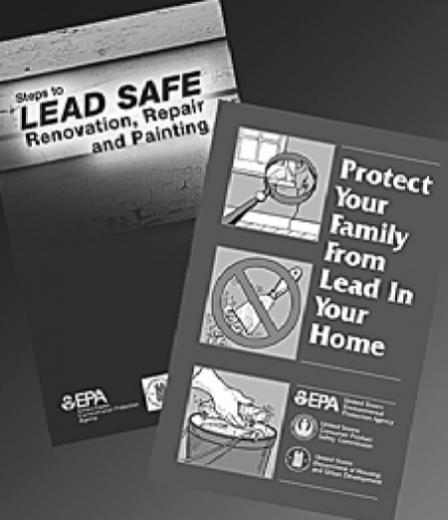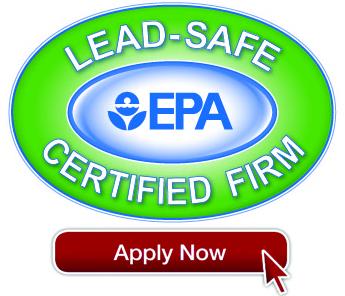Renovation, Repair and Painting Program: Contractors
If you are a renovation firm we recommend you read through all the tabbed sections to learn how to fulfill your legal requirements to protect yourself, your employees, and your clients from the dangers of lead exposure.
As a contractor, you play an critical role in helping to prevent lead exposure. Ordinary renovation and maintenance activities can create toxic lead dust that can harm your customers, workers, and even yourself. But by following lead-safe work practices, you can prevent lead hazards.

On this page you'll find:
Renovation program overview
The Lead Renovation, Repair and Painting (RRP) Rule establishes requirements for firms and individuals performing renovations, and affects contractors, property managers, and others who disturb painted surfaces. It applies to work in houses, apartments, and child-occupied facilities (such as schools and day-care centers) built before 1978. It includes pre-renovation education requirements as well as training, firm certification, and work practice requirements.
Firms that require certification
In general, anyone who is paid to perform work that disturbs paint in housing and child-occupied facilities built before 1978 must be certified. This includes all firms, even sole proprietorships.
Examples of the types of firms covered:
- Residential rental property owners/managers
- General contractors
- Special trade contractors, including
- Painters
- Plumbers
- Carpenters
- Electricians
Firms can’t advertise or perform renovation activities covered by the regulation in homes or child occupied facilities built before 1978 without firm certification.
Activities covered by the rule
- In general, any activity that disturbs paint in pre-1978 housing and child-occupied facilities is covered, including:
- Remodeling and repair/maintenance
- Electrical work
- Plumbing
- Painting preparation
- Carpentry
- Window replacement
- The following housing or activities are not covered by the rule
- Housing built in 1978 or later
- Housing specifically for elderly or disabled persons, unless children under 6 reside or are expected to reside there
- "Zero-bedroom" dwellings (studio apartments, dormitories, etc.)
- Housing or components declared lead-free by a certified inspector or risk assessor. Also, a certified renovator may declare specific components lead-free using an EPA recognized test kit or by collecting paint chip samples for analysis by an EPA recognized laboratory
- Minor repair and maintenance activities that disturb 6 square feet or less of paint per room inside, or 20 square feet or less on the exterior of a home or building. (Note: Window replacement, and partial and full demolition activities, are always covered regardless of square footage. Activities designated as “prohibited” are prohibited regardless of square footage.)
Paint testing
Paint testing is not required by the regulation, but unless you have documentation that the paint is not lead-based, then the requirements of the renovation regulation apply.
If you or your client chooses to have the paint tested prior to renovation, testing must be done on all surfaces to be affected by the work, by the appropriate qualified professional.
| Type of Paint Testing for Renovations | Who can do the testing? |
|---|---|
| EPA-recognized test kits | Certified renovators |
| X-Ray Fluorescence instruments | Certified lead-based paint inspectors or risk assessors |
| Paint chip sampling | Certified renovator, inspector or risk assessor |
Have a question?
EPA's renovation, repair and painting rule requires both firms and people to be certified. This section provides information about firm certification, where EPA is responsible for the renovation program, as well as how to apply and what fees are required.
On this page you'll find:
Determine if you apply to EPA or your state, tribe or territory
EPA's renovation program applies to all states, tribes and territories where EPA has not specifically provided authorization for that state, tribe or territory to operate the program themselves. Therefore, if you do work in an area other than the states or the tribe listed in the paragraph below, proceed to: Apply for EPA Firm Certification.
Contractors working in these states: Alabama, Delaware, Georgia, Iowa, Kansas, Massachusetts, Mississippi, North Carolina, Oklahoma, Oregon, Rhode Island, Utah, Washington, and Wisconsin, or in the Bois Forte Tribe should follow the link provided for the state or tribe for more information about their training and certification requirements. These states are authorized to administer their own RRP programs in lieu of the federal program. By following the state links above, you will leave the EPA web site. Note that if you work in more than one state, you may need both EPA and state certification.
RRP rule requires firm certification
Federal law requires all renovation, repair, and painting firms (including sole proprietorships) working in housing, or facilities where children are routinely present, built before 1978, to be certified. Firm certification is a key requirement to ensure the training of individuals and the use of lead-safe work practices. Firms must apply to EPA for certification to perform renovations or dust sampling. To apply, a firm must submit a completed application and fee to EPA online.
- All applications, payments, updates and certificate replacement requests are done online (payment methods include credit card, debit card, or electronic check).
- EPA RRP firm certifications are good for five years.
- When applying for recertification, your new certification begins when your old one expires. You’re not penalized for applying early.
- Application processing takes a week or two. Once complete your approval will be delivered by email from lead.paint@epa.gov. Please add the email address lead.paint@epa.gov to your contacts to ensure delivery of the approval in your inbox.
- The approval email will include a personalized “Lead-Safe Certified Firm” logo and instructions for its use. Feel free to use the logo on your advertising materials in accordance with the logo use guidelines.
- Firms can check the status of their certification application, download a copy of a recently issued certificate or retrieve their customized lead program logo. To access this service firms goto EPA's E-Enterprise portal, login in with their CDX user name and password, then go to the “progress tracker” section.
Firm responsibilities
Firms performing renovations must ensure that:
- All individuals performing activities that disturb painted surfaces on behalf of the firm are either certified renovators or have been trained by a certified renovator.
- A certified renovator is assigned to each renovation and performs all of the certified renovator responsibilities.
- All renovations performed by the firm are performed in accordance with the work practice standards of the Lead-Based Paint Renovation, Repair, and Painting Program.
- Pre-renovation education and lead pamphlet distribution requirements of the Lead-Based Paint Renovation, Repair, and Painting Program are performed.
- The program’s recordkeeping requirements are met.
When should recertification applications be submitted?
- You must apply for a re-certification at least 90 days before the firm's current certification expires.
- If a complete application, including the proper fee, is postmarked 90 days or more before the date the firm's current certification expires, the application will be considered timely and sufficient.
- In that case, the firm's existing certification will remain in effect until its expiration date or until EPA has made a final decision to approve the re-certification application, or not, whichever occurs later.
- The expiration date for the firm's re-certification will be 5 years from the date the existing certification expired, regardless of when the re-certification is approved.
- However, in cases where a complete application is postmarked less than 90 days before the date the current certification expires, if EPA does not approve the re-certification application before the existing application expires, the firm's certification expires.
- In this case, the recertification application will be regarded as a new certification, and the expiration date will be five years from when this new certification is issued.
- The firm will not be able to conduct renovations until EPA approves this new certification application.
- Similarly, if the firm submits an incomplete application for re-certification and EPA does not receive all of the required information and fees before the date the firm's current certification expires, or if the firm does not submit its application until after its certification expired, EPA will not approve the firm's re-certification application.
- Again, the recertification application will be regarded as a new certification, and the expiration date will be 5 years from when this new certification is issued.
- The firm will not be able to conduct renovations until EPA approves this new certification application.
- If EPA does not approve the application, the Agency will provide the applicant with the reasons for not approving the re-certification application. Any fees submitted by the applicant will not be refunded, but the firm can submit a new application for certification, along with the correct amount of fees, at any time.
If my information changes do I have to amend my application?
- A firm must amend its certification within 90 days of a change to information included in its most recent application. Examples of amendments include a change in the firm's name without transfer of ownership, or a change of address or other contact information. If a firm fails to amend its certification within 90 days of the date the change occurs, it will not be authorized to perform renovations until its certification has been amended.
- Amending a certification will not affect the validity of the existing certification or extend the certification expiration date. EPA will issue the firm a new certificate if necessary to reflect information included in the amendment. Firm certifications are not transferable. If the firm is sold, the new owner must submit a new initial application for certification.
- Amend your application online
Fee Schedule
| Fee type | Amount |
|---|---|
| Renovation Firm Certification/Recertification | $300 (this fee is $20 for a tribal firm) |
| Lead-based Paint Activities Certification/Recertification (Abatement, Inspection, Risk Assessment) | $550 (this fee is $20 for a tribal firm) |
| Combined Renovation and Lead-based Paint Activities Firm Application | $550 (this fee is $20 for a tribal firm) |
| Replacement Certificate | $15 |
Fee Refund Policy
Firms having submitted an application and associated fees for certification or re-certification who wish to withdraw their application prior to Agency approval will receive a fee refund based upon the schedule listed below. Firms who request a refund more than 10 days after the Agency receives the application will receive only a partial refund.
| Number of Days Following Agency Receipt of Application | Percent Reimbursable (based upon total fees submitted) |
|---|---|
| up to 10 days | 100% |
| 11 to 60 days | 75% |
| 61 to 120 days | 50% |
| 121 or more days | 25% |
Note: Refunds will only be made after EPA verifies fee receipt and deposit by the U.S. Treasury. Firms must notify the Agency in writing in order to qualify for a refund. The date of withdrawal is the date on which the Agency received the withdrawal notification. EPA will not refund fees after granting a firm certification or re-certification. If your application is disapproved, EPA will not refund fees. Refunds are not available for replacing a certificate. Refund and withdrawal requests must be sent to the following address:
U.S. EPA
P.O. Box 14417
Washington, DC 20044-4417
Have a question?
EPA's renovation, repair and painting rule requires each firm to be certified, to have at least one certified renovator, and for the remainder of employees involved in renovation activities to either also be certified renovators or be trained on the job by a certified renovator. This section provides information on how to become a certified renovator.

Overview of training requirements
Federal law requires that a “certified renovator” be assigned to each job, and that all involved individuals are trained in the use of lead-safe work practices.
- To become a certified renovator, a person must complete a renovator training course accredited by EPA or an EPA authorized program which will teach them how to work lead safe.
- All remaining individuals must also be trained. They can either be certified renovators (meaning they successfully completed the accredited training) or they can have been trained on the job by a certified renovator (such training must be documented and the documents must be retained).
- Locate an RRP training class or provider in your area.
Training requirements for certified renovators
- Renovators are certified upon completion of an EPA accredited renovator training course.
- Their course completion certificate serves as their certification credential.
- For initial certification, renovators must take an 8-hour training that includes 2 hours of hands-on learning.
- To remain certified a renovator must complete a refresher training course before their current certification expires.
- The expiration date is based on when the course was taken (see table below).
- For recertification, renovators must take a 4-hour refresher training that includes hands-on learning every other time they take the refresher course.
- Renovators who take the online refresher training will be certified for three years; renovators who take the hands-on training in the refresher course will be certified for five years.
- If certification expires, the 8-hour course must be taken again to regain certification.
|
Date course completed |
Expiration |
|---|---|
|
On or before March 31, 2010 |
March 31, 2016 |
|
From April 1, 2010 - March 31, 2011 |
6 years from the date of course completion |
|
On or after April 1, 2011 |
5 years from the date of course completion |
Certified renovator responsibilities
Certified renovators are responsible for ensuring overall compliance with the Lead-Based Paint Renovation, Repair, and Painting Program’s requirements for lead-safe work practices at renovations they are assigned.
A certified renovator:
- Must provide on-the-job training to other workers (who have not taken the certified renovator training course) on the lead safe work practices to be used in performing their assigned tasks.
- Must be physically present at the work site when warning signs are posted, while the work-area containment is being established, and while the work-area cleaning is performed.
- Must regularly direct work being performed by other individuals to ensure that the work practices are being followed, including maintaining the integrity of the containment barriers and ensuring that dust or debris does not spread beyond the work area.
- When requested by the party contracting for renovation services, must use an EPA-recognized test kit or must collect paint chip samples, submit them to an EPA-recognized laboratory, and obtain test results from the laboratory to determine whether components affected by the renovation contain lead-based paint. Note: you must assume lead-based paint is present for housing and buildings covered by this rule, unless testing is done that determines the components affected are lead-free.
- Must be available, either on-site or by telephone, at all times renovations are being conducted.
- Must perform project cleaning verification.
- Must have with them at the work site copies of their initial course completion certificate and their most recent refresher course completion certificate.
- Must prepare required records.
Have a question?
EPA's Renovation, Repair and Painting Rule requires safe work practices where lead paint is disturbed by renovation activities. These practices minimize the creation of dust and debris, prevent it from leaving the work area, and require cleaning of the work area to ensure occupant safety.

Work practice requirements
Work practice requirements include pre-renovation education requirements as well as lead-safe work practice requirements.
- Pre-renovation education requirements:
- Firms that perform renovations for compensation in residential houses, apartments, and child-occupied facilities built before 1978 are required to distribute EPA's lead hazard information pamphlet "Renovate Right" before starting renovation work.
- The firm must document compliance with this requirement; EPA's pre-renovation disclosure form may be used for this purpose.
- Training, certification, and work practice requirements:
- Firms are required to be certified, their employees must be trained in the use of lead-safe work practices (either as a certified renovator or on-the-job by a certified renovator), and lead-safe work practices that minimize occupants’ exposure to lead hazards must be followed.
- Examples of lead-safe work practices include:
- Work-area containment to prevent dust and debris from leaving the work area
- Prohibition of certain work practices like open-flame burning and the use of power tools without HEPA exhaust control
- Thorough clean up followed by a verification procedure to minimize exposure to lead-based paint hazards
Recordkeeping
- Records required to be on the job site:
- Copies of the certified renovator's initial and most recent refresher course completion certificates.
- Records required to be maintained for each job for a period of three years:
- Copies of the certified renovator's initial and most recent refresher course completion certificates
- Non-certified worker training documentation
- Designation of a certified renovator to the job
- Information on and results of use of EPA-recognized test kits or paint chip samples by a certified renovator who acted as the representative of the certified firm at the job site and who conducted testing for the presence of lead-based paint on surfaces to be affected by the renovation
- Lead-based paint inspection reports provided by a certified lead inspector or certified lead risk assessor, if applicable
- Proof of owner/occupant pre-renovation education
- Any other signed and dated documents from the owner(s) and/or residents regarding conduct of the renovation and requirements in the EPA RRP Rule
- All reports required from the certified firm and the certified renovator by the EPA RRP Rule.
Additional Requirements when Working in HUD housing
In addition to EPA's Renovation, Repair and Painting regulations, the U.S.. Department of Housing and Urban Development (HUD) requires compliance with its Lead Safe Housing Rule in target housing receiving HUD assistance. Read about HUD's requirements.
Have a question?
This page contains helpful resources to aid in your understanding of EPA's renovation, repair and painting program and provide useful tools to help you comply with those requirements.

On this page you'll find:
Brochures
- Renovate Right - Important Lead Hazard Information for Families, Child Care Providers, and Schools -- General information about legal requirements for safe lead practices for homeowners, tenants, child care providers and parents during renovation activities.
- Small Entity Compliance Guide to Renovate Right - EPA's Lead-based Paint Renovation, Repair and Painting Program | en Espanol -- A handbook for contractors, property managers, and maintenance personnel working in homes, child care facilities, and schools built before 1978.
- Steps to LEAD SAFE Renovation, Repair and Painting -- Information for contractors and homeowners on how to plan for and complete a home renovation, repair or painting project in pre-1978 housing and child-occupied facilities using lead-safe work practices.
- Paint Chip Collection Guide -- A guide for certified renovators for the collection and submission of paint chip samples for analysis by a laboratory recognized by the National Lead Laboratory Accreditation Program (NLLAP). Please note that your state may have further restrictions on this activity.
Sample forms
- Pre-Renovation Disclosure Form -- A sample of the form to be signed by the owner or tenant confirming that they received a copy of the lead pamphlet before renovations begin.
- Renovation Notice and Record of Tenant Notification Procedures -- Samples of the forms used to notify occupants of renovation activities in the common area(s) of multi-family housing.
- Sample Record Keeping Checklist -- To make recordkeeping easier, EPA has developed this checklist to help contractors comply with the renovation recordkeeping requirements that became effective April 22, 2010.
Legislation, regulation and policy
- 40 CFR Part 745 -- Lead-Based Paint Poisoning Prevention in Certain Residential Structures
- Residential Lead-Based Paint Hazard Reduction Act of 1992 | (TXT)
- Learn more about the history of the RRP rule
- Read about additional requirements for work in Federally assisted housing
Other resources
- Newsroom
- Renovation program newsletter archive
- Get RRP outreach materials for contractors
- Get information on purchasing EPA-recognized lead paint test kits
- Confused about the difference between abatement and RRP?
- Fee information
- Information on renovation/repairs resulting from natural disasters


